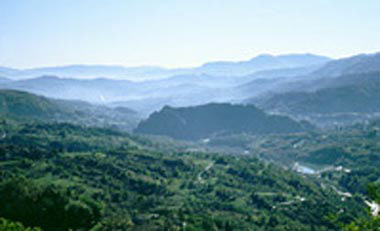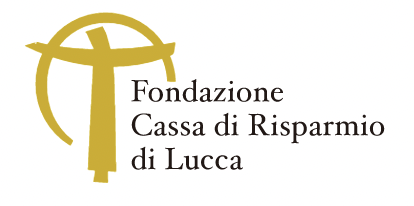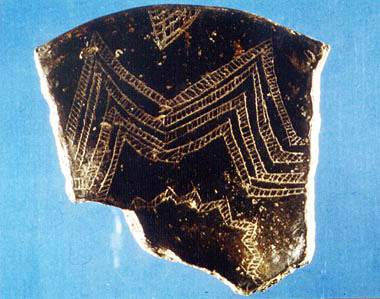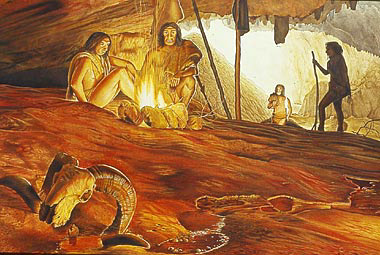
The climatic changes occurred already since 14000 years ago in the Mediterranean area and northern Europe conventionally marks the passage from Pleistocene to the Holocene, the last and present climatic phase, which includes Palaeolithic and all the following cultural periods. The classification of Mesolithic cultures is not however referred to climatic changes but to the specific technological changes in the production of instruments. These did not occur at the same time in all geographic areas. The dating obtained for Middle-Eastern archaeological settlements belonging to the Mesolithic indeed goes back further than European Mesolithic ones, because cultural and technological conquests occurred in those areas in an earlier period. Mesolithic cultures in Europe developed between 10,000 and 7,000 years ago.
During the Mesolithic (or middle stone age) the gradual but constant rises in average annual temperatures, which had already brought about a major decrease in ice caps over a large part of Northern Europe and Alpine area, caused important changes in the life habits of human population living in all the inland areas of Europe and the Mediterranean basin.
The passage from nomadism practised by Palaeolithic hunters to a definitive sedentarism, a characteristic of the majority of agricultural communities during the following Neolithic period, was every where a gradual and complex phenomenon. Archaeological data illustrates this evidence in its various aspects in different zones of Africa, Europe and the Near East.
In the Middle-Eastern area, findings of sickles and cereal grinders, already in the Mesolithic period, are related to harvesting wild cereals which only grew spontaneously in those zones. This natural availability of precious food resources created the opportunity for the groups of hunters to remain for a long time in areas which were rich in such resources to be exploited. This therefore reduced migration over a wide range, favouring an ever longer use of those same areas during the various seasons of the year.
The first strategies concerning sheep and goat breeding also took place in the Middle-East. Such attempts would lead later to pastoral practices (Neolithic period). In several Mesolithic settlements in the Middle-Eastern area and Europe, findings of bones of wolves and jackals remains with different characteristics compared with the once of wild animals show that they were the first "dogs" to be domesticated by man since 15,000 years ago.
An important change in artistic production is also noted: the naturalistic art style which had been very typical of the Palaeolithic disappeared and both "wall art" or "movable art" were characterised by a geometric style. During the Mesolithic, in Europe, Italy and the Middle-East, personal ornaments and amulets made of bone, shells and stone are very common.
There are no great changes in the burial customs as compared to Palaeolithic: the corpse was usually buried in the caves, into a pit dug in the earth often together with stone and bone artefacts and various ornaments. The burials of Mesolithic hunters from Mondeval de Sora (Belluno) and Mezzocorona (Trento) are famous as the corpses were painted all over using ochre, sheltered by big rocks and accompanied by pieces of animals as food supplies, as well as ornaments and instruments obtained from bone and flint.
Given that the ever growing communities started living in the same areas for long periods of time, the tradition of choosing a specific place for burials arose and collective graves where excavated. At Grotta dell'Uzzo near Trapani, on the island of Sicilia, ten graves of adults and children were discovered. These are know as one of the most important expressions of a Mesolithic funerary complex in the Mediterranean area.
Following the improvement in climatic conditions during the Mesolithic period, in Italy, the high mountains zones, which were previously covered with ice, saw the growth of vegetal species which had been typical of places situated at a lower altitude, and were populated by animals typical of cold environment with rare tree vegetation, such as the ibex and chamois. In the lowland and around the areas at the foot of the mountains, forests expanded and there was a notable increase in forest animals such as the deer, roebuck and wild boar. Archaeological finds and studies carried out in different areas tell us that human inhabitation of the mountain zones which had already begun during the final phase of the Upper Palaeolithic age, reached in this period a height of 2000 metres.
The strategy of seasonal exploitation of the different ecological areas favoured a better utilisation of the territory resources: during winter, human communities lived in the areas of the valley bottom, while in summer they exploited the mountainous zones, placing the settlements above the limit of the wooden area. The rarefaction or extinction of the large size mammals such as the mammoth, rhinoceros and cave bear, were balanced by an increase in small game. Therefore during this period, human groups dedicated themselves to hunting small animals, which had been less sought after previously such as beaver, badger, lynx and wild cat. Another source of food, particularly available in damp and marshy areas, included birds, eggs and turtles. Further more, many Mesolithic settlements situated near seas and lakes provided the first evidence of substantial and repeated fishing activity with a related picking of molluscs. The evidence of the last activity is given by numerous findings of empty shells collections which are known as "shell wastes".
With the increase in available resources and therefore the opportunity of a wider choice of favourable settlement areas, the human communities gradually moved from a constant nomadic existence, related to the game migration, to a semi-nomadic life consisting of limited movements in smaller areas.
Details:
Evidence of Mesolithic housing structures is quite rare all over the world. The most exceptional archaeological discoveries were made in the Middle-East where human communities, which already harvested wild cereals, lived in caves or built circular shaped huts with stone bases and covering of thatched materials. In Europe we have a small evidence of European housing structures, mainly based on "pole holes" remains (that is, marks left in the ground by wooden structures which supported walls and roof) as well as on concentrations of carbon, evidence of ancient hearths.
The settlements were mainly built outside or in rock shelters and a strong preference for damp environments, such as the lakes banks, along the riverside or near the sea, is been evidenced. In north-western area of Toscana the Mesolithic settlements were more numerous than those of the final phases of the Upper Palaeolithic age and they are concentrated in the high Valle del Serchio and in the Appennino tosco-emiliano. However, a decrease in the number of settlements situated in the lowlands and low hills is noted, while a high increase in camps at high altitudes (1500-1800 m. above sea level) is evidenced. Small groups of hunters-gatherers arranged their camps on the banks of little lakes at high altitudes, building few base camps and moving diffusely on the territory, camping for short time. While, during the earliest phase of the Mesolithic, "base-camps" were situated from medium to low altitudes, at approximately 400-500 metres (Isola Santa, Riparo Fredian and Piazzana), with the exception of the site at Bagioletto Alto, later the settlements were transferred towards high altitudes (Le Coste, Passo della Comunella and Lama Lite) because these were used as seasonal camps mainly during the summer times.
It is really possible that numerous settlements were also situated on coastal and lake areas, but these have not been found as they were wiped out by the rising of the sea level. In fact Mesolithic instruments have been found in the submerged sediments of Lago di Massaciuccoli. In the north Tuscan inland, it is however documented that lowland along water flows, as well as low hill areas were frequented. This custom is been well evidenced at Sammartina in Florentine Valdarno, at Casa Gentile in the Pistoia area and in the settlements around Livorno running from the coast at Calafuria to the internal hills. (text by ALESSANDRA BERTON, MARZIA BONATO, STEFANIA CAMPETTI, LAURA PERRINI)
The economy of the population, in north-western area of Toscana, during the Mesolithic age, was still based on hunting and fruit picking. Bones remains founded in the settlements of Riparo Fredian and Riparo Piastricoli in Garfagnana, prove that while hunting during the final phase of the Upper Palaeolithic was exclusively based on ibexes, it was then replaced by the hunting of deer, which became the main source of food. They also hunted small mammals such as hares, rabbits and beavers and increased the gathering of the abundant vegetal resources constituted of berries and wild fruits.
The collection of hazel-nuts is well evidenced, particularly from the medium to low altitudes of Garfagnana given the findings of numerous carbonised shells remains.
During the Mesolithic period, the lithic industry is characterised by flint instruments which are even smaller in size than those belonging to the final phase of Upper Palaeolithic. Indeed they are only a few millimetres long and geometric shaped, in form of trapeziums, triangles and half-moons. These tiny instruments, which were fitted into the sides of wooden spears, constituted the "armatures" (sharp-edged pieces) of arrows and multiple sharp edged harpoons, which were used for hunting and fishing. The invention of the bow also dates back to the Mesolithic period replacing the propulsor, as instrument for launching arrows during hunting.
In Toscana, findings from Mesolithic lithic industries are quite numerous: the settlements of Isola Santa and Riparo Fredian are the most important occurrences in the study of prehistory, because they document a continual occupation of the same area spanning from the Upper Palaeolithic through the Mesolithic period.
In the mountains, seasonal base camps, where the main group activities took place, were alternated with camps used for shorter periods where specialised activities, such as the watching of animal herds or the supplies of primary raw materials took place. According to archaeological data, there was a difference in the lithic industry between settlements at lower and higher altitudes: there were more "armatures" (sharp-edged pieces) in the high altitudes sites, which were probably used for specialized hunting activities; on the contrary the used daily tools, such as scratchers and scrapers were more frequently produced in the sites at intermediate altitude or in the coastal plain. (text by ALESSANDRA BERTON, MARZIA BONATO, STEFANIA CAMPETTI, LAURA PERRINI)
In Toscana a lot of important data has been obtained from studies carried out during different geological drillings on the deep strata of the coastal strip. In fact, both the study of fossil pollens and marine/terrestrial organisms, typical of the different periods, adapted to warm or cold temperature fluctuations, have allowed us to quite exactly reconstruct the climate and different geographic aspects of the territory.
The slow climatic improvement that, since 18,000 years ago, caused a progressive sea level rise, determined a new separation of the Arcipelago islands from the Tuscan coast 12,000 years ago. Geologists established that the coast line was at its present level around 6,000 years ago. Furthermore, because of the accumulation of fluvial sediments at the mouth of the rivers Magra, Serchio and Arno, the present morphology of the coast and inland was gradually evidenced. A long sandy beach formed between Bocca di Magra and Livorno, while a series of inland dunes, parallel to the coast, took place intercalated with more or less extensive lake areas. The residue of these is represented today by the Lago di Massaciuccoli and in a northern area by the ancient Lago di Porta which is now largely covered with earth.
The inland vegetal environment 14,000 years ago was characterised by extensive mountainous grassland and scattered pine, fir, and broadleaf woods including oaks and hazel-nut trees at lower altitudes. Later, between 10,000 and 9,000 years ago, because of the increase in temperature in the high mountain zones, where vegetation consisted of juniper and bilberry bushes, Scots pine woods gradually spread. Between 9,000 and 8,000 years ago the climate became progressively milder, caracterized by more temperate winters and rather hot summers.
In the mountains since 8,000 years ago, little lakes remained in ice hollows. Mesolithic groups, who also frequented the ridges and Apennine crossings, lived on their shores. Scattered laburnum, maple and ash woods developed at high altitudes, while half way up the mountainsides of the Appennini and Apuane, mixed woods with conifers and broadleafs (cluster pine, oaks and so on) spread. Silver and red firs were not foreign with this vegetal environment. (text by ALESSANDRA BERTON, MARZIA BONATO, STEFANIA CAMPETTI, LAURA PERRINI)







